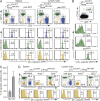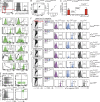In vivo fate mapping identifies pre-TCRα expression as an intra- and extrathymic, but not prethymic, marker of T lymphopoiesis
- PMID: 23509324
- PMCID: PMC3620354
- DOI: 10.1084/jem.20122609
In vivo fate mapping identifies pre-TCRα expression as an intra- and extrathymic, but not prethymic, marker of T lymphopoiesis
Abstract
Expression of the pre-T cell receptor α (pTα) gene has been exploited in previous studies as a molecular marker to identify tiny cell populations in bone marrow (BM) and blood that were suggested to contain physiologically relevant thymus settling progenitors (TSPs). But to what extent these cells genuinely contribute to thymopoiesis has remained obscure. We have generated a novel pTα(iCre) knockin mouse line and performed lineage-tracing experiments to precisely quantitate the contribution of pTα-expressing progenitors to distinct differentiation pathways and to the genealogy of mature hematopoietic cells under physiological in vivo conditions. Using these mice in combination with fluorescent reporter strains, we observe highly consistent labeling patterns that identify pTα expression as a faithful molecular marker of T lineage commitment. Specifically, the fate of pTα-expressing progenitors was found to include all αβ and most γδ T cells but, in contrast to previous assumptions, to exclude B, NK, and thymic dendritic cells. Although we could detect small numbers of T cell progenitors with a history of pTα expression in BM and blood, our data clearly exclude these populations as physiologically important precursors of thymopoiesis and indicate that they instead belong to a pathway of T cell maturation previously defined as extrathymic.
Figures








Similar articles
-
A pTalpha-negative subpopulation of CD25+ TN thymocytes revealed by a transgenic marker.Scand J Immunol. 2002 Feb;55(2):119-28. doi: 10.1046/j.1365-3083.2002.01022.x. Scand J Immunol. 2002. PMID: 11896928
-
Human T-cell leukemia virus type 1 Tax protein down-regulates pre-T-cell receptor alpha gene transcription in human immature thymocytes.J Virol. 2007 Jan;81(1):301-8. doi: 10.1128/JVI.00766-06. Epub 2006 Oct 18. J Virol. 2007. PMID: 17050604 Free PMC article.
-
T cell receptor gamma gene regulatory sequences prevent the function of a novel TCRgamma/pTalpha pre-T cell receptor.Immunity. 1998 Jun;8(6):713-21. doi: 10.1016/s1074-7613(00)80576-2. Immunity. 1998. PMID: 9655485
-
Decision checkpoints in the thymus.Nat Immunol. 2010 Aug;11(8):666-73. doi: 10.1038/ni.1887. Epub 2010 Jul 20. Nat Immunol. 2010. PMID: 20644572 Free PMC article. Review.
-
Molecular mechanisms that control mouse and human TCR-alphabeta and TCR-gammadelta T cell development.Semin Immunopathol. 2008 Dec;30(4):383-98. doi: 10.1007/s00281-008-0134-3. Epub 2008 Oct 17. Semin Immunopathol. 2008. PMID: 18925397 Review.
Cited by
-
ILC Differentiation in the Thymus.Adv Exp Med Biol. 2022;1365:25-39. doi: 10.1007/978-981-16-8387-9_3. Adv Exp Med Biol. 2022. PMID: 35567739
-
Noncanonical mode of ERK action controls alternative αβ and γδ T cell lineage fates.Immunity. 2014 Dec 18;41(6):934-46. doi: 10.1016/j.immuni.2014.10.021. Epub 2014 Nov 28. Immunity. 2014. PMID: 25526308 Free PMC article.
-
Molecular evidence for a thymus-independent partial T cell development in a FOXN1-/- athymic human fetus.PLoS One. 2013 Dec 9;8(12):e81786. doi: 10.1371/journal.pone.0081786. eCollection 2013. PLoS One. 2013. PMID: 24349129 Free PMC article.
-
A complex of Neuroplastin and Plasma Membrane Ca2+ ATPase controls T cell activation.Sci Rep. 2017 Aug 21;7(1):8358. doi: 10.1038/s41598-017-08519-4. Sci Rep. 2017. PMID: 28827723 Free PMC article.
-
Ca2+ Homeostasis by Plasma Membrane Ca2+ ATPase (PMCA) 1 Is Essential for the Development of DP Thymocytes.Int J Mol Sci. 2023 Jan 11;24(2):1442. doi: 10.3390/ijms24021442. Int J Mol Sci. 2023. PMID: 36674959 Free PMC article.
References
-
- Akashi K., Richie L.I., Miyamoto T., Carr W.H., Weissman I.L. 2000. B lymphopoiesis in the thymus. J. Immunol. 164:5221–5226 - PubMed
Publication types
MeSH terms
Substances
LinkOut - more resources
Full Text Sources
Other Literature Sources
Molecular Biology Databases
Research Materials

